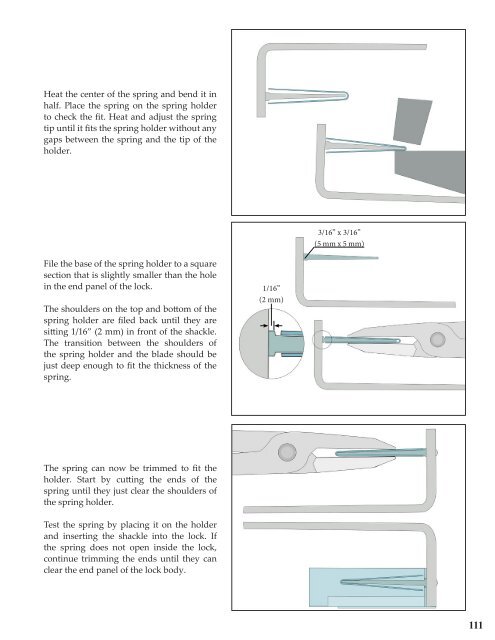The New Spruce Forge Manual of Locksmithing: A Blacksmith’s Guide to Simple Lock Mechanisms
The New Spruce Forge Manual of Locksmithing: a Blacksmith’s Guide to Simple Lock Mechanisms is a totally revised and expanded version of the original work from 1999. This new hardcover edition, at 304 pages and with more than 800 color photos and illustrations, is more than double the size of the original manual. It is divided into two distinct sections: Technical Information - This section is a reference manual in itself that covers the specific tools and techniques needed to build all the parts for each lock, as well as providing the information needed to understand the assembly instructions outlined in the second section. The Locks: Patterns & Instructions - This section provides the plans and detailed instructions for each of the 14 lock projects in this new edition. The clear assembly instructions describe when and how to use the technical information provided in section one. The authors have maintained their original trademark style that relies on well-illustrated step-by-step instructions that guide you through the whole lock-making process. They have also kept their low-tech approach that demonstrates how to go about creating good work using only a handful of simple tools. Making blacksmith locks is an age-old skill the authors of this manual are helping to preserve by passing on their knowledge to this book’s readers. The New Spruce Forge Manual of Locksmithing is also an excellent introduction to benchwork, which is a useful skill for any blacksmith to acquire. This manual will become a valuable, trusted and often referred to sourcebook in your blacksmithing library. Hardcover, 304 pages, more than 800 photos and illustrations.
The New Spruce Forge Manual of Locksmithing: a Blacksmith’s Guide to Simple Lock Mechanisms is a totally revised and expanded version of the original work from 1999. This new hardcover edition, at 304 pages and with more than 800 color photos and illustrations, is more than double the size of the original manual.
It is divided into two distinct sections:
Technical Information - This section is a reference manual in itself that covers the specific tools and techniques needed to build all the parts for each lock, as well as providing the information needed to understand the assembly instructions outlined in the second section.
The Locks: Patterns & Instructions - This section provides the plans and detailed instructions for each of the 14 lock projects in this new edition. The clear assembly instructions describe when and how to use the technical information provided in section one.
The authors have maintained their original trademark style that relies on well-illustrated step-by-step instructions that guide you through the whole lock-making process. They have also kept their low-tech approach that demonstrates how to go about creating good work using only a handful of simple tools.
Making blacksmith locks is an age-old skill the authors of this manual are helping to preserve by passing on their knowledge to this book’s readers. The New Spruce Forge Manual of Locksmithing is also an excellent introduction to benchwork, which is a useful skill for any blacksmith to acquire. This manual will become a valuable, trusted and often referred to sourcebook in your blacksmithing library.
Hardcover, 304 pages, more than 800 photos and illustrations.
Create successful ePaper yourself
Turn your PDF publications into a flip-book with our unique Google optimized e-Paper software.
Heat the center <strong>of</strong> the spring and bend it in<br />
half. Place the spring on the spring holder<br />
<strong>to</strong> check the fit. Heat and adjust the spring<br />
tip until it fits the spring holder without any<br />
gaps between the spring and the tip <strong>of</strong> the<br />
holder.<br />
3/16” x 3/16”<br />
(5 mm x 5 mm)<br />
File the base <strong>of</strong> the spring holder <strong>to</strong> a square<br />
section that is slightly smaller than the hole<br />
in the end panel <strong>of</strong> the lock.<br />
<strong>The</strong> shoulders on the <strong>to</strong>p and bot<strong>to</strong>m <strong>of</strong> the<br />
spring holder are filed back until they are<br />
sitting 1/16” (2 mm) in front <strong>of</strong> the shackle.<br />
<strong>The</strong> transition between the shoulders <strong>of</strong><br />
the spring holder and the blade should be<br />
just deep enough <strong>to</strong> fit the thickness <strong>of</strong> the<br />
spring.<br />
1/16”<br />
(2 mm)<br />
<strong>The</strong> spring can now be trimmed <strong>to</strong> fit the<br />
holder. Start by cutting the ends <strong>of</strong> the<br />
spring until they just clear the shoulders <strong>of</strong><br />
the spring holder.<br />
Test the spring by placing it on the holder<br />
and inserting the shackle in<strong>to</strong> the lock. If<br />
the spring does not open inside the lock,<br />
continue trimming the ends until they can<br />
clear the end panel <strong>of</strong> the lock body.<br />
111










